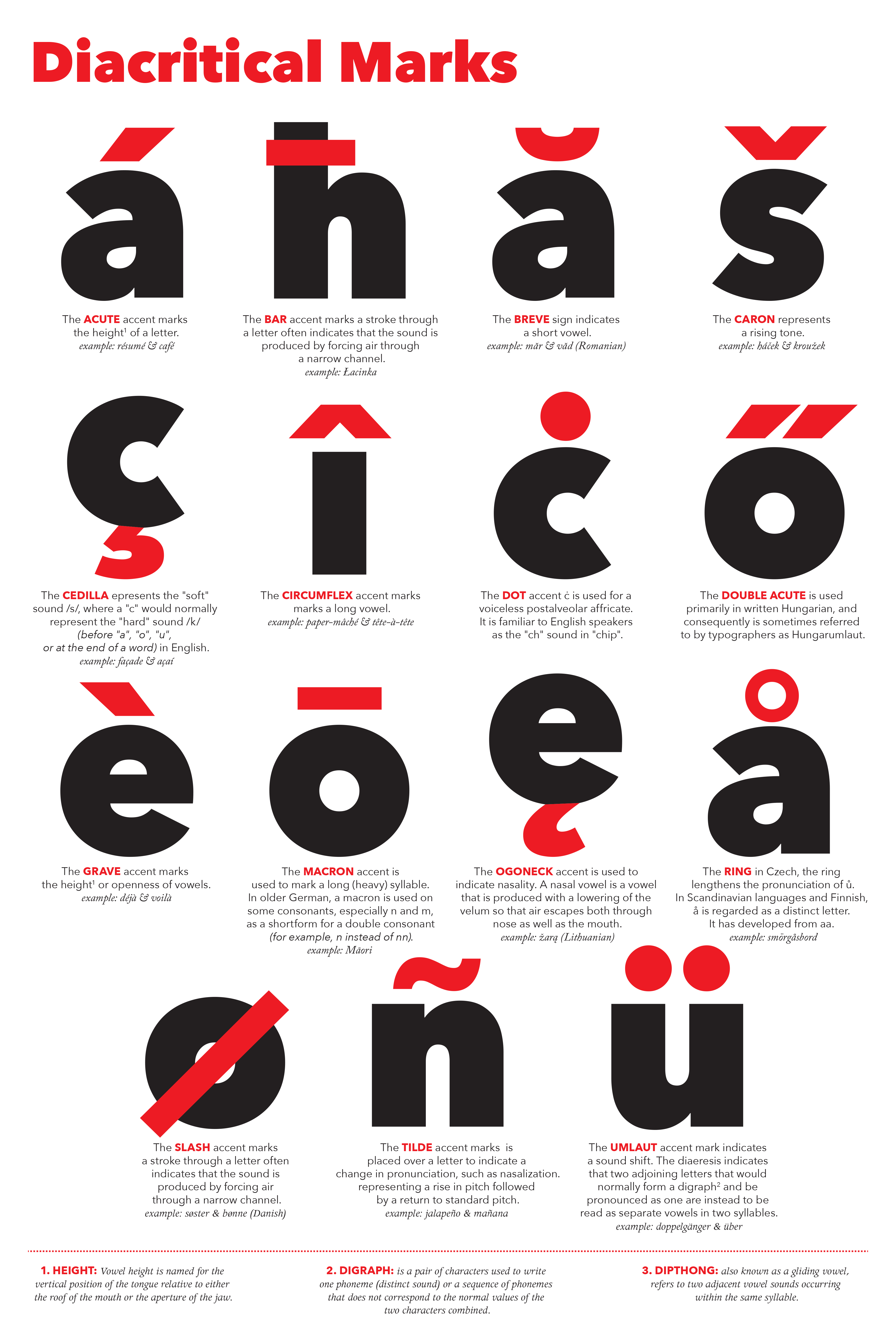

Diacritics may appear above or below a letter or in some other position such as within the letter or between two letters. Some diacritics, such as the acute (◌́ ) and grave (◌̀ ), are often called accents. The word diacritic is a noun, though it is sometimes used in an attributive sense, whereas diacritical is only an adjective. The term derives from the Ancient Greek διακριτικός ( diakritikós, "distinguishing"), from διακρίνω ( diakrī́nō, "to distinguish"). Without proper rendering support, you may see question marks, boxes, or other symbols.Ī diacritic (also diacritical mark, diacritical point, diacritical sign, or accent) is a glyph added to a letter or to a basic glyph. With some experience, you will be able to read these pronunciation symbols so quickly that they will become like a second language, and you will be able to practice words faster.This article contains special characters.
#Examples of diacritical marks how to#
Now let’s take a mini-test! Read the pronunciations and try to guess what the word is.īy learning how to read pronunciation symbols, you can learn how to correctly pronounce every word in the dictionary, which will help you in spelling bees. For example, the word “present” can have two different meanings depending on where you put the stress. Stress on the word can make all the difference in what it means. This means that the syllable after this sound also has some stress, but it is not as much as the primary stress. The diacritical mark (,) indicates secondary stress. This means that you put the most stress, or emphasis, on the syllable that comes right after this mark. The diacritical mark (‘) indicates primary stress. Stressed syllables are pronounced slightly louder and longer than unstressed syllables. If a syllable is stressed, that means you put some extra force or pressure as you say that syllable. Stress symbols tell you which syllable of the word has the most stress, or emphasis.
:max_bytes(150000):strip_icc()/AccentMenu-5bfee73146e0fb002686c463.jpg)
Notice how the letter ‘u’ in kummel is pronounced like a short ‘i,’ that’s how an umlaut works. One example is the word kummel, which is pronounced /kiməi/. An umlaut is used when a German vowel is pronounced like a mix of two vowel sounds. In German words, these two dots can also be called an umlaut. Ü- “oo” sound as in m oose or r ule or sh oe A diaeresis is used when the vowel ‘a’ or ‘u’ are pronounced like they are “stretched out”. This symbol gives a vowel a long sound.ĭiaeresis (also spelled dieresis, pronounced /dīˈerəsəs/): ä and üĪ diaeresis is two dots (. Macron (pronounced /mā-ˌkrän/): ā, ē, ī, ōĪ macron is a straight line ( − ) that is placed over a vowel. Whenever there is a plain vowel with no marks on it, it is pronounced with a short sound. This is often the hardest sound for a speller to figure out because it can be spelled with any vowel: a, e, i, o, u, or even y. This is a neutral vowel sound, pronounced like “uh,” as in b anan a, circ us, and c ollect. One of the most common diacritics is the schwa, which looks like an upside-down e (ə). In this post, we will break down this list of pronunciation symbols so you will become a master in reading diacritical marks!

Learning all these symbols may be overwhelming for new spellers. (You can find a complete list of all Merriam-Webster pronunciation symbols at ). In any dictionary entry, the pronunciation symbols will be right next the spelling of the word. A frequently asked question from any aspiring speller is “How do you know the correct pronunciation of a word?” The Merriam-Webster dictionary has a system of pronunciation symbols (also called diacritical marks or diacritics) that will tell you how to pronounce the word.


 0 kommentar(er)
0 kommentar(er)
